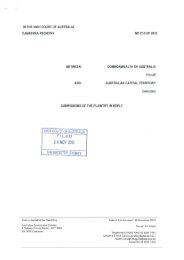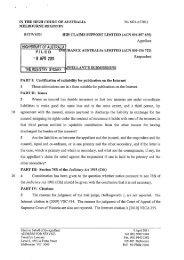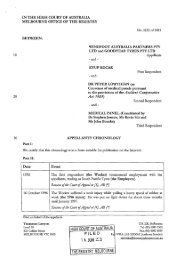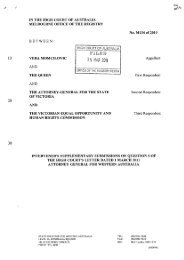Written submissions - High Court of Australia
Written submissions - High Court of Australia
Written submissions - High Court of Australia
You also want an ePaper? Increase the reach of your titles
YUMPU automatically turns print PDFs into web optimized ePapers that Google loves.
imprisonment and it did qualifY (by virtue <strong>of</strong>s 160 <strong>of</strong> the Crimes Act 1914) for the<br />
benefits provided by s I 0 <strong>of</strong> the Sentencing Act.<br />
Although the learned sentencing judge can scarcely be blamed for the enor (because<br />
no one had brought these matters to his attention), it would, in my view, seem to be a<br />
relevant factor in the sentencing process to consider what the relevant legislative body<br />
(namely the Commonwealth) regarded as the appropriate "sentencing tariff" for an<br />
<strong>of</strong>fence perpetrated against its interests or the interests <strong>of</strong> bodies for whom it had power<br />
to legislate. In R v Whitna/1 (1993) 42 FCR 512 ... , Drummond J (sitting as a member<br />
<strong>of</strong> the Fuii Comt <strong>of</strong> the Federal <strong>Court</strong> which was considering an appeal against a<br />
10 sentence imposed under s 29D <strong>of</strong> the Crimes Act 1914) said (at 520; ... ):<br />
"As Davies and Higgins JJ point out, these <strong>of</strong>fences could have been<br />
prosecuted under various other provisions and, at the election <strong>of</strong> the<br />
prosecution, could have been dealt with summarily rather than on indictment<br />
-ail steps which would have limited the maximum sentence that could have<br />
been imposed on the respondent to much less than the 10 years' imprisonment<br />
and a fine <strong>of</strong>$10,000 which he faced for each conviction under s 29D. While<br />
it is solely for the prosecuting authority to select the provision under which it<br />
wiii launch a prosecution, the court is not bound to treat the prosecution<br />
decision as placing a fetter upon the court's sentencing discretion in the sense<br />
20 <strong>of</strong> compeiiing the court to impose a heavier sentence than it would regard as<br />
appropriate but for that one consideration."<br />
The principle being enunciated in that passage means no more than this: that although<br />
it is for the prosecuting authority in its absolute discretion to determine which particular<br />
charge it wiii lay against an accused person, it is none the less relevant and proper for<br />
the judge on sentence to take into account as a relevant sentencing principle the fact that<br />
there was another and less punitive <strong>of</strong>fence which not only could have been charged but<br />
indeed was as appropriate or even more appropriate to the facts alleged against the<br />
accused. (Emphasis added.)<br />
30 32. The <strong>Court</strong> <strong>of</strong> Appeal was correct to confirm the underlying rationale for the<br />
12<br />
principle in R v Liang & Li: In R v McEachren, 34 Redlich JA explained the rationale<br />
underlying the principle in R v Liang & Li in these terms:<br />
40<br />
[It is] part <strong>of</strong> a broader principle requiring fairness in the sentencing process.<br />
Consistency in sentencing is a mechanism by which fairness in the sentencing process is<br />
to be achieved. It requires that the court should strive to impose similar punishment for<br />
similar <strong>of</strong>fences committed by <strong>of</strong>fenders in similar circumstances. Conversely,<br />
disparity in sentencing can only be justified if there are acceptable and convincing<br />
grounds for differentiating between <strong>of</strong>fences or <strong>of</strong>fenders. Unfairness wiii arise where<br />
there is an inconsistent application <strong>of</strong> legal principles.<br />
3 3. The <strong>Court</strong> <strong>of</strong> Appeal in the present case appeared to approve <strong>of</strong> these remarks? 5 It is<br />
submitted that the <strong>Court</strong> was correct to do so.<br />
34. The <strong>Court</strong> erred in confining the principle to intra-State comparisons: However, it is<br />
submitted that the Comt <strong>of</strong> Appeal erred in holding that the principle in R v Liang & Li is<br />
34<br />
(2006) 15 VR 615 at [55].<br />
35<br />
Pantazis & Ors v The Queen [2012] VSCA 160 at [28]. See also the brief discussion <strong>of</strong> R v Liang & Li by<br />
Pr<strong>of</strong>essors Fox and Freiberg in Sentencing: State and Federal Law in Victoria, Oxford University Press, 2•' edn,<br />
1999, at [2.205].
















